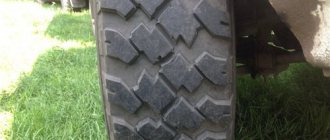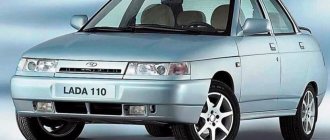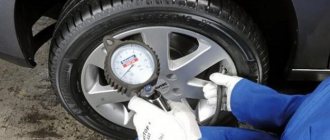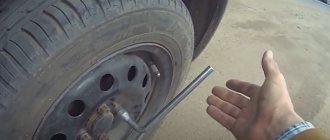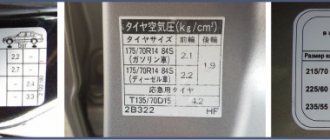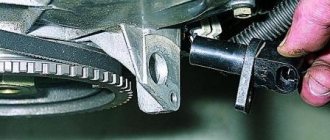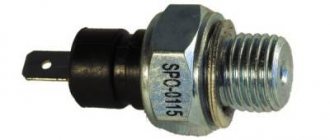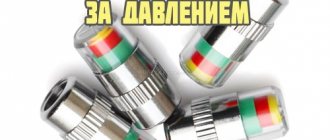The pressure in Volkswagen Polo tires must comply with the standards established by the manufacturer. Each modification has its own parameters. Front and rear wheels have different indicators. The degree of inflation is affected by the time of year the car is used and the quality of the road. If only the driver is behind the wheel, then the front and rear of the Volkswagen can be inflated at a level of 2.0 atm. When the car is fully loaded, the tires on the front axle should be inflated to 2.4, and the rear axles to 2.6. On the Polo GT sports car, under standard load, the front tires receive a pressure of 2.2 atm, and the rear tires - 2.0 atm. Under load, the main ones are 2.4, and the rear ones are 2.8.
It is necessary to monitor the tire pressure immediately after the car leaves the factory. Otherwise, with low inflation, increased rubber wear will be observed. If the boost is increased, then due to reduced contact with the road surface, vehicle handling will deteriorate.
Tire pressure Polo R15
When using such tires, the wheel inflation parameters correspond to R14 tires. In summer, the front and rear wheels are inflated to 2.0 and 1.8 atm. In winter, tire parameters decrease by 10% relative to the presented value.
When installing R15 tires, when the car carries a large number of passengers and there is cargo, in the summer the front is inflated to 2.4 atm, and the rear to 2.6. In winter it also decreases by 10%.
Frequency of pressure checks
Previously, tube tires required periodic pressure checks - once a week. With the advent of butyl rubber tubes, there was no need for frequent inspection. The use of modern technologies allows us to limit ourselves to an external inspection.
Tire pressure measurement
Ideally, it is necessary to check the tire pressure at least once every 30 days, and before a long trip it is mandatory!
Tire pressure Volkswagen Polo
To answer the question of what pressure should be in the tires of a Volkswagen Polo, you need to read the vehicle’s technical operation manual - the pressure must correspond to that specified by the car manufacturer.
The manufacturers of the Volkswagen Polo have made a “cheat sheet” for drivers on the gas tank hatch. An elementary way to find out the pressure is to open the tank hatch.
However, there is a category of drivers who do not agree with the manufacturer and are ready to challenge his recommendations. According to the table, the pressure in the tires of a Volkswagen Polo when fully loaded on the rear axle should be 2.6 atm. This rule applies to tires with diameters R14 and R15.
Pressure parameters in Volkswagen Polo
The reason where these pressure values come from lies in the testing of cars for all characteristics, including tire pressure, before releasing the car into series. A fully loaded car means that it contains almost 600 kg – that’s 5 people, including the driver, and about 100 kg of cargo. The technical instruction manual states that the maximum load of the Volkswagen Polo sedan is 576 kg.
If you often transport cargo or 3–4 passengers, then the normal tire pressure in your Volkswagen is 2.4 atm. — on the front axle, 2.6 atm. – on the rear. The value indicated in column 1 of the table is -2 atm. - front and 1.8 atm. - rear, applicable only when only the driver drives and does not transport other people or cargo.
What could be the pitfalls - changes in pressure standards determined by Volkswagen. In frosty weather, the pressure in the wheels decreases, sometimes by up to 0.5 atm. In winter, tire pressure should be checked more often.
IMPORTANT! A low tire at sub-zero temperatures has better grip on the road surface and the braking distance is reduced by about 5%. But at the same time, an under-inflated tire wears out 30% more than an inflated tire according to the standard recommended by Volkswagen.
Volkswagen Polo
The choice is up to the car owner, but the grip of a wheel with pressure below normal is much worse, and the chances of flying off the road into a ditch with lowered wheels are much higher. It is considered reasonable to reduce tire pressure in winter within 10% of the maximum value. Otherwise, when loading the car in one trip, you can lose half the studs from the tires.
Tire pressure Volkswagen Tiguan
Are tire pressures the same or different for all Volkswagen models? What is the tire pressure of a Volkswagen Tiguan?
The Volkswagen Tiguan is highly reliable. It can serve for many years without breakdowns, but this is only if the car is properly cared for. A certain category of car owners forget that wheels are one of the components of safe driving. Not only a flat tire, but also inappropriate tire pressure can cause trouble for the driver.
Volkswagen Tiguan
As on other Volkswagen models, the manufacturer's recommended tire pressure for the Volkswagen Tiguan is indicated on the gas tank flap.
The advantage of the Tiguan model compared to its analogues is the presence of a tire pressure monitoring system. This system is designed to transmit information to the driver about the pressure in each of the wheels. Information is displayed on the dashboard. The operating principle of the system is based on the presence of sensors and transmitters in each of the wheels.
When driving, tire pressure sensors in the Volkswagen Tiguan provide information about the pressure of each wheel. The automation located in each of the sensors instantly detects a decrease in tire pressure. Using installed sensors, the system recognizes a decrease in the radius of one of the wheels, which is perceived by the sensor as a decrease in pressure in one of the wheels. The corresponding command is indicated by the warning light on the instrument panel coming on.
The table on the Volkswagen Tiguan tank cap indicates the pressure:
— front and rear – 2.2 atm.;
- full load - 2.5 atm. – front, 2.7 atm. - butt
Tire pressure Volkswagen Passat
The Volkswagen Passat, like the Tiguan, is equipped with Volkswagen tire pressure sensors. The optimal tire pressure for the Passat is indicated in the table located on the back of the gas tank hatch. However, the optimal pressure provided in the table applies to the tires installed by the manufacturer. As a rule, the manufacturer installs wheels with a diameter of R16 or R17 on Volkswagen Passat.
According to the table, it is recommended to maintain a pressure of 1.9 atm. - on both axes. At maximum load, you can increase the pressure:
- in front - 2.2 atm.;
- rear – 2.7 atm.
If the Passat has tires of a different size, for example R15, then you need to pump the wheels based on the advice of the tire manufacturer. Manufacturers of high-quality tires usually indicate all the necessary characteristics on the side of the tire (pressure, size, speed index, etc.), and the information of interest can be obtained from the tire seller. Sensors will control the level of pressure in the tires after they are installed.
IMPORTANT! Regarding the tire pressure of the Passat, as well as any other car, it is worth considering a number of features. For a long trip on a flat surface, it is better to slightly increase the pressure to the maximum possible value, and when driving on “dirt” and sand, lower it to the permissible maximum. Regarding the Passat - further work of the pressure sensor!
Tire pressure monitoring system Polo sedan
The function provides the driver with information about tire problems. In each wheel of the car, behind the spool rod, there is a sensor that supplies information to the control unit. If one of the tires is flat, the light on the instrument panel begins to blink. This continues for 1 minute. When the fault is not corrected, it continues to light continuously.
Sometimes, after installing the spare tire, the light remains on. The reason is that the new sensor has not been initialized. Only after completing the procedure will the light go out.
Also on the Polo Sedan there may be indirect control of the roller inflation. It is based on fixing the number of wheel revolutions. An ABS unit is installed in the car. If the tire pressure decreases, the outer diameter of the wheel decreases and the number of revolutions decreases. Based on the information, the sensors give a signal about insufficient pumping.
European Internal Market (EUDM)
Tires for Volkswagen Polo Sedan 1.4 TSI 2019
European internal market
The hole in the center of the disk is known as the center hole diameter
.
Measured in millimeters. Factory installed discs have a center hole diameter that matches the diameter of the hub boss. In this case, the load is distributed on the hub, and the disk itself is centered, which avoids vibration
at high speeds.
The wheels are attached to the car hubs with bolts or studs and nuts. In the second case, the studs are rigidly fixed in the hub. The clamping parts of the wheel fastening bolts and nuts can be conical or spherical and must necessarily coincide with the profile of the holes in the wheel disk, as they ensure correct alignment of the wheel on the hub.
Metric thread example: M12 x 1.25
Thread diameter (mm) x thread pitch (mm)
Inch thread example: 9/16″ - 18 UNF
Thread diameter (in inches) - thread pitch
UNF - unified inch thread with fine pitch
Rim width (in inches) x wheel rim diameter (in inches)
ET35 - disc offset (distance between the wheel disc mounting plane and the rim symmetry plane, mm), positive 35 mm.
This is the diameter of an imaginary circle drawn through the centers of the disk mounting holes.
PCD is measured in mm. For example, 4×100 means that the wheel has 4 mounting holes and the diameter of the imaginary circle through the centers of the mounting holes is 100 mm.
Recommended cold tire pressure, measured in bar or PSI.
Rim width (in inches) x wheel rim diameter (in inches)
ET35 - disc offset (distance between the wheel disc mounting plane and the rim symmetry plane, mm), positive 35 mm.
This is the diameter of an imaginary circle drawn through the centers of the disk mounting holes.
PCD is measured in mm. For example, 4×100 means that the wheel has 4 mounting holes and the diameter of the imaginary circle through the centers of the mounting holes is 100 mm.
Recommended cold tire pressure, measured in bar or PSI.
Rim width (in inches) x wheel rim diameter (in inches)
ET35 - disc offset (distance between the wheel disc mounting plane and the rim symmetry plane, mm), positive 35 mm.
This is the diameter of an imaginary circle drawn through the centers of the disk mounting holes.
PCD is measured in mm. For example, 4×100 means that the wheel has 4 mounting holes and the diameter of the imaginary circle through the centers of the mounting holes is 100 mm.
Recommended cold tire pressure, measured in bar or PSI.
Rim width (in inches) x wheel rim diameter (in inches)
ET35 - disc offset (distance between the wheel disc mounting plane and the rim symmetry plane, mm), positive 35 mm.
This is the diameter of an imaginary circle drawn through the centers of the disk mounting holes.
PCD is measured in mm. For example, 4×100 means that the wheel has 4 mounting holes and the diameter of the imaginary circle through the centers of the mounting holes is 100 mm.
Pressure in the slopes of the Polo sedan in summer and winter
Typically, a car is equipped with alloy wheels with R15 -185 60, R15 195/55 tires. Be sure to adhere to certain standards for pumping up stingrays. Parameters change depending on the release date of the VW Polo modification.
- 2011. If R15 tires are installed, then in summer in good weather on a flat road the pressure in the front should be 2.1 atm, and in the rear 1.9. In winter the norm is different: 2.0 and 1.8 atm. The same pressure should be in the tires when driving on a wet road or unpaved surface.
- 2012. In the summer with R15 tires - 185/60, the pressure is 2.1 in the front and 1.9 in the rear. In winter, the degree of pumping should decrease within 0.1-0.2 atm. The wheels are lowered by the same amount in wet weather.
- 2013. Boost standards correspond to Polo 2012.
- 2016. For R15 tires, the pressure in summer should be 1.9 atm. In winter and bad weather, 1.9 will do.
- 2018. Similar to 2016 cars.
- 2019. With R15 185/60 tires, the drivers pump up to 2.1 in the summer, the driven ones 1.9 atm. For R16 tires, inflation rates are 2.2 at the front and 2.0 atm at the rear. All these indicators decrease by 10% in winter and bad weather.
Manufacturer's recommended tire sizes
By distributing its products in various countries, the manufacturer strives to maximally optimize and refine its cars to meet the needs and requirements of the market. Trying to know the operating conditions as best as possible, Volkswagen locates production facilities outside of Germany.
Local factories also select their own tire supplier. Hence, there may be a variation in the variations of tires used. Recommendations for choosing tire sizes are conventionally divided into the markets of Europe, North America, and China.
For European market
Not everything is simple with the European market; it is divided into Western European and Eastern European. The first includes EU countries and Scandinavia. Based on this, the manufacturer and dealers have developed their own strategy for different road conditions. So for southern countries it is preferable to install softer tires with a larger diameter. For northern, Scandinavian countries, rubber resistant to low temperatures is installed. The main points of operation are:
- good road surface;
- mostly stable speed limit;
- low level of wear.
The Eastern European market is associated with more difficult operating conditions for both the vehicle as a whole and the tires as well. For tires, these are more difficult operating conditions, resulting in poor quality roads. Sometimes this is the absence of asphalt roads at all. The following countries are usually classified as countries:
- Russia;
- Ukraine;
- Belarus.
Among the conditions of use are:
- poor quality of road surface;
- instability of climatic conditions;
- increased wear.
Due to different conditions, different approaches are used in equipping a car with wheels. First of all, this affects the radius and height of the tire. For Western Europe these are 17 or 18 inch wheels. For the Eastern European market, 14-inch tires will be the base.
For North American market
The roads of the United States of America and Canada are famous not only for their long length, but also for their consistently good asphalt surface. At the same time, the market is affected by different climatic conditions.
Canada and Alaska are located in the north, which means more cold-resistant tires. It is worth noting the traditional commitment of North Americans to all-season tires.
For China market
The dynamically developing automobile market in the Middle Kingdom is making adjustments to Volkswagen's production plans. The Volkswagen Polo sold in the local market is different from other countries. The need to equip cars with tires is also not ignored. Taking into account the state of the road network and operating conditions, the manufacturer considered it necessary to install R14 tires as standard.
Table of sizes and tires recommended by the manufacturer for installation on Volkswagen Polo (sedan, hatchback)/
| Radius | Size |
| R14 | 175/70 |
| R15 | 185/60 195/55 |
| R16 | 195/55 |
| R17 | 205/40 |
| R18 | 215/40 |
According to Volkswagen, the Polo model is not equipped with R16 tires from the factory. This is possible as tuning and exclusively for summer tires. It is recommended to install the given dimensions on vehicles equipped with appropriate engines.
Tire pressure of VW Polo hatchback
The required inflation rates are indicated on the inside of the gas tank cap and on the door openings, depending on the year of production. There is the following information:
- When installing R14 tires and loading two people into the car, the leading ramps should be inflated to 2.3 atm, and the rear ones to 2.1. Full load means pumping up to 2.5 and 2.9. This applies to summer and when driving on a good road.
- On R15 tires and with 2 passengers - in summer the front is inflated to 2.0, and the rear to 1.9 atm. In winter, it is necessary to reduce the indicators within 0.1-0.2.
Pressure norm table
The optimal inflation parameters for Polo tires of various modifications are presented in the table.
| Polo bodies | Standards in atm | With load | Without | in winter | ||||
| Front | Rear | P | Z | P | Z | P | Z | |
| Sedan | 2,1 | 1,9 | 2,5 | 2,3 | 2,0 | 1,8 | 2,4 | 2,2 |
| Hatchback | 2,3 | 2,1 | 2,5 | 2,9 | 2,1 | 1,9 | 2,3 | 2,6 |
| Liftback | 2,0-2,2 | 1,8-1.9 | 2,1-2,3 | 2,0 — 2,1 | 1,9-2,1 | 1,7-1,8 | 2,0-2,2 | 1,9-2,0 |
It is advisable to adhere to these standards established by the manufacturer.
Volkswagen Polo Sedan 2013, 105 l. With. - tires
Comments 19
I download: front 2 rear 1.8. when I was carrying 4 in the back I pumped 2.6. it's all written there on the hatch
And my monometer is new and, according to the seller Bibi, the best one lies at 0.2.
Today at the gas station I checked and bleeded it. Muzzle 2.0, rear 1.9. And it’s just raining! I made a couple of turns and everything was fine. Well, for comfort, as they say, I steer with one hand... I wipe away tears of happiness with the other)))
When the pressure is less than 2, lateral stability suffers, the car begins to chatter, turns worse, consumption increases and acceleration dynamics suffer. I have 2.2.
try to take turns without a clutch-) At 2 it’s not childish to drag your ass-)
I also wanted to say that on all cars, on the tank flap there is information about tire pressure. Open it and look)))
Opened it and looked! 1.8 muzzle and a little more rear with a small load. When the machine is heavily loaded, the pressure increases significantly. I'm trying to find a middle ground because... On weekdays I’m alone in the car, and on weekends the whole family plus luggage to the dacha.
Everything has been calculated for a long time. And the pressure is written at the curb weight of the car and the air temperature is 20 degrees, and the car is at sea level! This is to be precise. In general, it is influenced by the composition of the rubber, the outside air temperature, driving style, and much more. It’s not worth overpumping. If you drive vigorously and heat up, the pressure in the tires will increase further, and this is not good. Something like this. Well, you need to check with different pressure gauges. There is a difference of 0.5 atmospheres between the two pressure gauges))).
I have a sticker on the tank flap in front of 2.4 and back of 2.6! golden mean 2.2
Source www.drive2.ru
